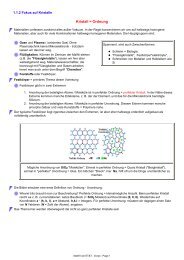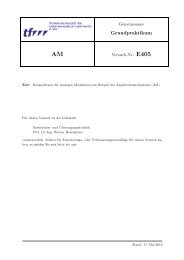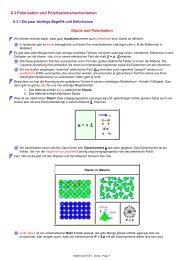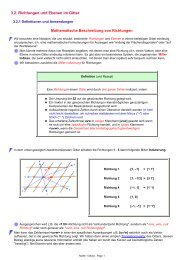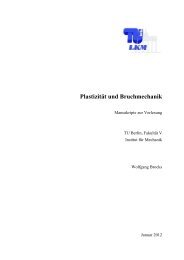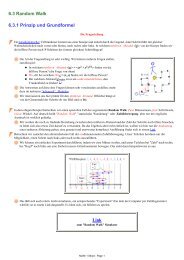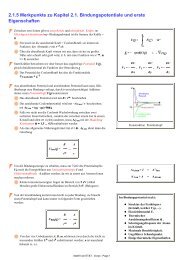ORGANIC SEMICONDUCTORS Christian Ohrt, Thomas Preuße ...
ORGANIC SEMICONDUCTORS Christian Ohrt, Thomas Preuße ...
ORGANIC SEMICONDUCTORS Christian Ohrt, Thomas Preuße ...
Create successful ePaper yourself
Turn your PDF publications into a flip-book with our unique Google optimized e-Paper software.
<strong>ORGANIC</strong> <strong>SEMICONDUCTORS</strong><br />
<strong>Christian</strong> <strong>Ohrt</strong>, <strong>Thomas</strong> Preuße<br />
Faculty of Enginering, University of Kiel<br />
Kaiserstraße 2 24143 Kiel Germany<br />
ABSTRACT: This paper deals with a short introduction into the field of organic semiconductors. Its part of a<br />
presentation, which is hold in the course material science seminar for the fifth semester students of the bachelor<br />
material science study. We want to give a overview about the history, the structures and bondings, the opctical<br />
properties, the conductive properties and some applications of organic semiconductors in our present time for<br />
example OLEDs. Then we will show some advantages of using organic semiconductors in comparison to typical<br />
inorganic semiconductors like Si and GaAs. The semiconductor technology is one of the most important deployments<br />
in the world and is required in nearly all applications of high technology. One way to improve the properties of this<br />
technology can be to use organic semiconductors.<br />
1 Historical background<br />
The first discovery of organic semiconductors was<br />
made in the year 1963 by D. E. Weiss and the members of<br />
his group. They discovered high conductivity in ioine-<br />
”doped” oxidized polypyrrole blacks. They could achieve<br />
a conductivity of 1 Siemens/cm, which is equivalent to a<br />
resistance of 1 Ohm/cm. In 1965 they were able du reduce<br />
the resistance 0.03 Ohm/cm with other conductive<br />
polymers. Unfortunately this work was lost until recently.<br />
In 1974 John McGuiness together with his group built a<br />
voltage-controlled organic-polymer switch, which consist<br />
of melanin, a self-doped mixed copolymer of oxidized<br />
polyacetylene, polypynole and polyaniline. This material<br />
emitted a flash of light when it switched. In the year 1977<br />
conductivity in polymers was rediscovered and reported<br />
by Alan J. Heeger, Alan G. McDiamid and Hideki<br />
Shirakawa. They reported high conductivity in similarly<br />
oxidized and iodine-doped polyacetylene. In the year 2000<br />
they received the Nobel Prize in Chemistry “For the<br />
discovery and development of conductive organic<br />
polymers", which was leading to some disputes, because<br />
of the earlier discovery in this field especially by D. E.<br />
Weiss.<br />
2 Properties of organic semiconductors<br />
2.1 Basic properties<br />
Organic semiconductors are low molecular weight<br />
materials with fundamentally different bondings as their<br />
inorganic counterparts. Organic semiconductors have a<br />
conjugated π-electron system beeing formed by the by the<br />
pZ-orbitals of sp² hybridized C-Atoms in the molecules.<br />
The π–bonding is significant weaker then σ-bonding and<br />
the energy gap of π– π* transitions is about 1.5 to 3 eV,<br />
but the energy gap can be controlled by the degree of<br />
conjugation in the molecule.<br />
π-electron system beeing formed by the by the<br />
pZ-orbitals of sp² hybridized C-Atom<br />
The consequences: Organic semiconductors have a<br />
reduced hardness and a lower melting point as inorganic<br />
semiconductors and much weaker delocalization of<br />
electronic wave functions of neighbouring molecules<br />
which has direct appplications for optical properties and<br />
charge carrier transport.<br />
2.2 Optical properties<br />
Organic semiconductors have well-defined spin states,<br />
the so called singlet and triplet state. These two states<br />
derive from quantum mechanics, more precisely from the<br />
multiplicity. The singlet state is responsible for<br />
fluorescence and the triplet state is responsible for<br />
phosphorescence. To describe phosphorescence we need<br />
the term of intersystem crossing. Intersystem crossing<br />
means, that an electron changes its spin, after it was<br />
excited by a photon. After the intersystem crossing, it can<br />
not reduce its state of energy by spontan emission like in<br />
flourenscence, the electron changes the system again and<br />
than it can go back to the origin energy state by emiting<br />
weak radiation, the so called phosphorescence.
Singlet and triplet states<br />
2.3. Conductive Properties<br />
Several kinds of carriers mediate conductivity in organic<br />
semiconductors. These include π-electrons and unpaired<br />
electrons. Almost all organic solids are insulators. But<br />
when their molecules have π-conjugate systems, electrons<br />
can move in the so called π-electron cloud. In charge<br />
transfer complexes, even unpaired electrons can stay<br />
stable for a long time, and are the carriers. This type of<br />
semiconductor is also obtained by pairing an electron<br />
donor molecule and an electron acceptor molecule. Thats<br />
how you can dope organic semiconductors.<br />
3 Applications<br />
3.1 OLEDs<br />
An organic light-emitting diode (OLED) is a lightemitting<br />
diode (LED) whose emissive electroluminescent<br />
layer is composed of a film of organic compounds. The<br />
layer usually contains a polymer substance that allows<br />
suitable organic compounds to be deposited. They are<br />
deposited in rows and columns onto a flat carrier by a<br />
simple "printing" process. The resulting matrix of pixels<br />
can emit light of different colours.<br />
Such systems can be used in television screens,<br />
computer displays, portable system screens, advertising,<br />
information and indication. OLEDs can also be used in<br />
light sources for general space illumination, and largearea<br />
light-emitting elements. OLEDs typically emit less<br />
light per area than inorganic solid-state based LEDs<br />
which are usually designed for use as point-light sources.<br />
Operation mode of an OLED<br />
4 Advantages and disadvantages of organic<br />
semiconductors<br />
One of the main reasons for developing organic<br />
semiconductors instead of inorganic is their potential for<br />
lower costs than silicon devices . Also their mechanical<br />
properties (less weight, more flexible and elastic, easier<br />
to produce in form of thin layers by pecial printing<br />
techniques) are some advantages over their inorganic<br />
counterparts. Disadvantages are their higher chemically<br />
activity, which means, that they need more protection by<br />
encapsulation. Because of lower melting point they are<br />
more temperature sensitive in comparison to inorganic<br />
semiconductors and finally is the process of the charger<br />
transfer mechanisms not understood for 100 %.<br />
5 Future Trends<br />
In the present time OLED displays are still very<br />
expensive as you can see at the new XEL-1 by Sony.<br />
With a cost of 1700$ and a display with only 11 inch the<br />
new OLED displys are still to expensive. But OLED<br />
displys have some advantages. For example: The displays<br />
of the XEL-1 from Sony is only 2,5 cm thick.



